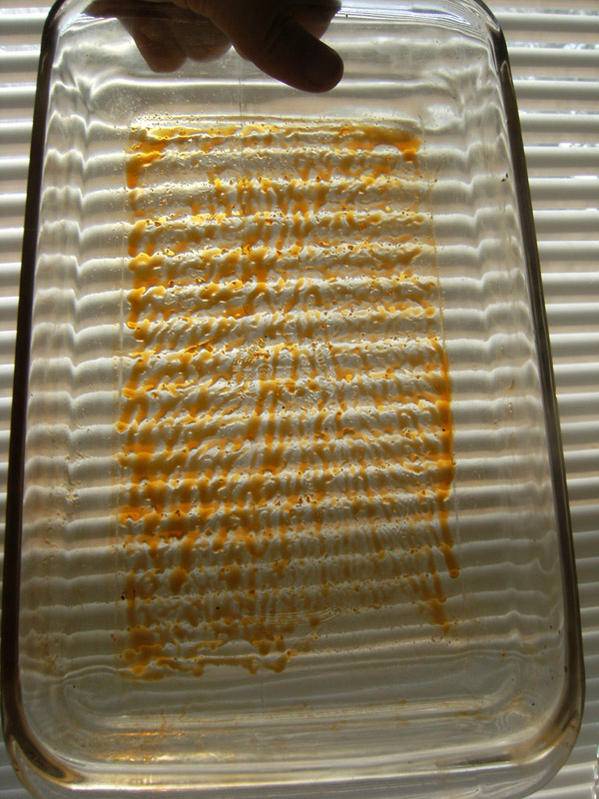Ipsissimus
Member
Wow is all I can say.

 I am stunned. Gold from nasty resin.
I am stunned. Gold from nasty resin.
Over the years I've found nothing cleans a bowl like hot rubbing alcohol. Bonus is you can let the alcohol evaporate and save the resin, if you are desperate - you get way more than you would with a paperclip, less mess. I've always wondered, how can I get goods, and leave the gunk?
I recently found that naptha or hexane will selectively grab the cannabinoids from the alcohol, leaving the tar and crap. You can then separate, and evap the solvent leaving the goods.
Step 1:
Place bowl in ziploc bag. Put enough 70% rubbing alcohol in the ziploc to submerge bowl partially. Zip it up, place in the microwave for 20-40 seconds, just long enough until the alcohol starts to boil and the bag starts to puff up. Alcohol boils at lower temperatures than water, so you can handle the bag like a hot potato. Cradle with a towel if need be, and shake like crazy. Open the ziploc, drain the alcohol through a coffee filter into a mason jar. If the bowl is still resinated, repeat.
The beauty of using the ziplock is that there is no smell - all the fumes from boiling are contained in the bag. Remove bowl, rinse, and the bowl is should be clean. This in itself is a great way to clean a bowl.
Step 2:
Add about 1/4 cup of naptha/hexane to the mason jar containing the black alcohol. Shake vigorously (no emulsion should form). The top solvent will turn a golden/reddish hue, and the alcohol will stay nasty and black on the bottom. Evaporate the solvent, leaving you with the cannabinoids. I separated the solvent by pouring the contents of the mason jar into a ziploc bag, allowed it to settle, then snipped the corner and allowed the alcohol (bottom layer) to pour back into the mason jar, then moved over a pyrex dish and evaporated the naptha with a hair dryer in a well ventilated area.
The oil only FAINTLY tastes of resin, and is more active than some straight iso-oil runs on herb I've done. I'll likely be doing this again, so I'll have more feedback on the process. I'll collect my cleaning alcohol in a mason jar, and then after I get a bunch, do this again.
*dislcaimer - make sure your similar solvent leaves no residue when evaporated on a mirror. otherwise you might be smoking petrol contaminants.

 I am stunned. Gold from nasty resin.
I am stunned. Gold from nasty resin.Over the years I've found nothing cleans a bowl like hot rubbing alcohol. Bonus is you can let the alcohol evaporate and save the resin, if you are desperate - you get way more than you would with a paperclip, less mess. I've always wondered, how can I get goods, and leave the gunk?
I recently found that naptha or hexane will selectively grab the cannabinoids from the alcohol, leaving the tar and crap. You can then separate, and evap the solvent leaving the goods.
Step 1:
Place bowl in ziploc bag. Put enough 70% rubbing alcohol in the ziploc to submerge bowl partially. Zip it up, place in the microwave for 20-40 seconds, just long enough until the alcohol starts to boil and the bag starts to puff up. Alcohol boils at lower temperatures than water, so you can handle the bag like a hot potato. Cradle with a towel if need be, and shake like crazy. Open the ziploc, drain the alcohol through a coffee filter into a mason jar. If the bowl is still resinated, repeat.
The beauty of using the ziplock is that there is no smell - all the fumes from boiling are contained in the bag. Remove bowl, rinse, and the bowl is should be clean. This in itself is a great way to clean a bowl.
Step 2:
Add about 1/4 cup of naptha/hexane to the mason jar containing the black alcohol. Shake vigorously (no emulsion should form). The top solvent will turn a golden/reddish hue, and the alcohol will stay nasty and black on the bottom. Evaporate the solvent, leaving you with the cannabinoids. I separated the solvent by pouring the contents of the mason jar into a ziploc bag, allowed it to settle, then snipped the corner and allowed the alcohol (bottom layer) to pour back into the mason jar, then moved over a pyrex dish and evaporated the naptha with a hair dryer in a well ventilated area.
The oil only FAINTLY tastes of resin, and is more active than some straight iso-oil runs on herb I've done. I'll likely be doing this again, so I'll have more feedback on the process. I'll collect my cleaning alcohol in a mason jar, and then after I get a bunch, do this again.
*dislcaimer - make sure your similar solvent leaves no residue when evaporated on a mirror. otherwise you might be smoking petrol contaminants.


 Even some bottled water like Dasani is treated city water.
Even some bottled water like Dasani is treated city water. 




